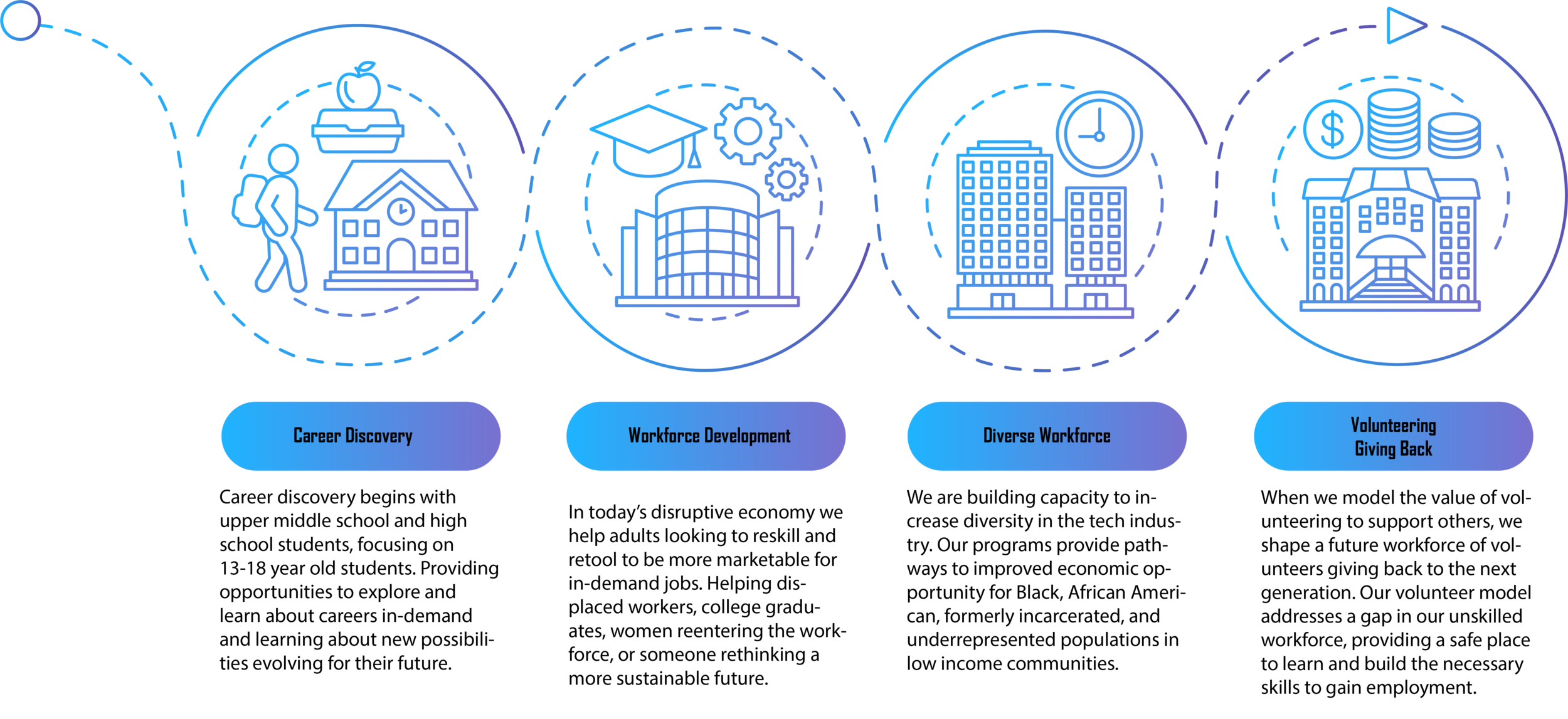Systemic Change
To create real change, it takes people who believe change is necessary, people who are committed to investing their time to create change, people that see the change first hand not only in those that they serve but those that are fulfilling the need for change. As a predominantly volunteer managed organization it is important that we learn to recruit, retain, train, and manage our volunteer community.
Hear how WCTD is addressing unemployment due to skills gaps through our real-world project program. This program model helps build skills and confidence in tech careers for those reentering or reskilling for in-demand jobs in an evolving economy.
During this time of COVID pandemic we are ensuring that those hit hardest by unemployment are able to participate in our workforce development programs. Through partnerships with Bridgehampton Child Care & Recreational Center, Family Service League, Council Of Thought & Action (COTA) and Nebula Academy we are creating new opportunities for change, opportunities to create sustainable careers in in-demand jobs in the technology industry.
Creating positive change through reskilling adults:
We evaluate the in-demand jobs in this continuously evolving economy to create programs that teach new skills and expose participants to new types of in-demand careers that require new forms of learning. Our programs are designed with a metacognitive pedagogy approach combined with industry relevance to ensure we bring value to participates with transferable skills ready to bring immediate value to employers.
Utilizing an agile Design Thinking Model we develop our programs in a five phase approach.
EMPATHIZE: To understand our diverse learning populations needs and the learning outcomes we seek, what do we need to actually teach, and what the end result should look and feel like for our learners.
DEFINE: Clarify the outcomes to ensure we are on the right path before going broad and investing unnecessarily.
IDEATE: Go broad by creating lots of ideas, generating mind maps, building with a team of educators, industry experts, and students.
PROTOTYPE: Create a sample one hour workshop to test the concepts, to flesh out the flow and outcomes. Build an initial framework of curriculum that will be integrated into the full curriculum post the testing phase.
TEST: Using opportunities where we have a large audience of participants, we test our assumptions for the underlying need and address our proposed curriculum. We fail fast and learn to build a model to improve outcomes.
Learning to fail fast when things do not always go according to plan has been key to our success. We create a full lifecycle through our program model by engaging young adults we create opportunities to be a part of a positive learning experience that transforms lives.
STRATEGIC PARTNERSHIPS AND MEASURING IMPACT
We have invested in alliances with many federal and statewide organizations , partnerships with the NYS Department of Labor, NYS School Board Association, NYS Superintendents Association, NYS Parent Teacher Association, Department of Homeland Security, and corporate and private industry groups like ISC2 and IAMCP, These partnerships help support awareness for students from hundreds of schools across NYS, and nationally to learn about new careers in cybersecurity, learn to code, learn about new careers in 3D printing, Digital Animation, Augmented and Mixed Realty, Bioengineering, and so much more. Our programs impact over 1000 students, teachers, parents, and adult volunteers each year. Our alignment with schools in economically disadvantaged communities continues to grow, with 75% of our program participants coming from these communities. With 43% of our participants young women learning about the possibilities for them in STEAM careers.
Our Model to create positive systemic change to build a more diverse workforce
Who we impact:
We continue to measure our outcomes through pre- and post-assessments. Evaluating our programs for impact and by measuring young adults in four subareas: Persistence, STEM Career Interest, Self-Esteem, and 21st Century Skill Development. For adults the four subareas are: Persistence, Self-Esteem, 21st Century Skills Development, and self-motivation.
Here is what are participants say about our programs through our assessments:
“Program was great learned a lot about coding and learned a lot about myself and the things I'm capable of doing.”
“It was excellent because I am a different person after gaining so many skills not only for the workforce but personally for my life overall.”
“Coming into the program looking to gain a foundation in programing I feel I was able to come away with that and so much more. This program helped challenge my problem solving skills, tested my leadership skills, taught me how to work in groups.”
Young Adult Programs for students ages 13-18
CODING TO SOLVE GLOBAL CHALLENGES
January 2021 will be our 6th year of delivering our Annual HACK-A-THON. This program impacts hundreds of students each year. With impact in multiple states including rural communities of Sandusky County, OH, and underrepresented low-income Black, and African American students in Darby, PA, to low-income communities on Long Island, NY. This program is an opportunity to support the efforts of a community to bring awareness of the career opportunities in STEAM and inform the diverse community of students how learning coding can empower positive change as well as support economic growth in manufacturing and engineering businesses. The HACK-A-THON is another example of how community engagement supports organic growth and impact for students, teachers, and the local businesses who support the program.




